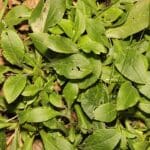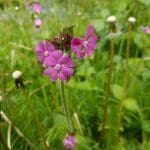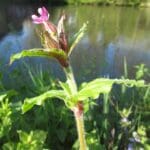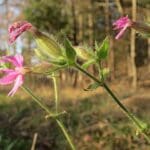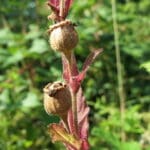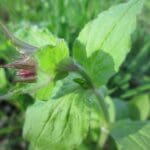Red Campion / Spring / Summer / Autumn / Winter / Edible
Red Campion is a common, native wildflower. It is a biennial or short-lived perennial plant that produces beautiful, bright pink flowers, which bloom in spring and early summer.
Common Names
Robin hood, Robin-run-in-the-hedge, Adder’s flower
Botanical Name
Silene dioica
Scientific Classification
Kingdom: Plantae
Order: Caryophyllales
Family: Caryophyllaceae
Physical Characteristics of Red Campion
Leaves
Leaves are hairy and oval with a pointed tip. The basal leaves are stalked whilst the upper leaves are stalkless. They grow in opposite pairs and are slightly sticky.
Flowers
The flowers are a bright pink with 5 petals that are deeply notched at the tip producing almost heart shaped petals. The petals narrow towards a calyx at the base. As Red campion is a dioecious the female and male flowers grow on separate plants.
Habitat
It’s generally found in woodlands, shaded hedgerows and prefers rich, damp and non-acidic soils.
Known Hazards
The plant is toxic to livestock, and can cause vomiting and diarrhoea if ingested
Could be Confused with
Could be confused with White Campion (Silene latifolia) which is mildly toxic as it contains saponins. White and red campion can hybridise which produces Pink Campion. White Campion has white blooms whereas Pink Campion can vary from whiteish to pale pink. The flowers of white and pink are bigger than that of the Red Campion.
A loose potential to be confused with rosebay willowherb purely because the flowers are the same colour, however willowherb grows much much taller.
Edible Uses of Red Campion
The young immature leaves can be wilted down to remove bitterness and used like spinach. You can also add the leaves to soups, salads, stir-fries and stews.
A traditional dish known as pistic from northern Italy uses the leaves from Red Campion.
Flowers were also used to make wine in Britain and you could use them to decorate cakes and desserts.
Notes on Herbal Uses
Plants of the genus Silene have roots that contain the chemical compound saponin, which although a mildly toxic substance has long been used as soap for washing clothes etc. There are also references to Red Campion being used to treat snake bites and as a cure for corns and warts.
Learn more about saponins here
Extra notes from the Foragers
Red campion has connections to the faeries and goblins and it’s believed that the blooms protect the faeries from being discovered. In some parts of Britain it’s believed to be bad luck to pick the flowers.



